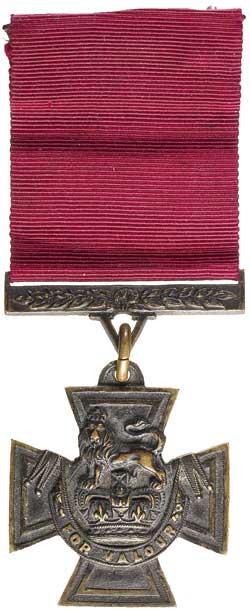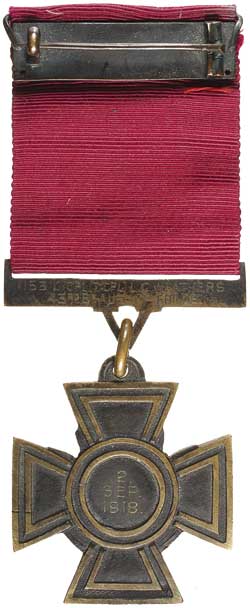Orders, Decorations & Medals - Australian Singles
Lot 4972 Session 18 (2.30pm Friday) Orders, Decorations & Medals - Australian Singles
Estimate $500,000
Bid at live.noble.com.au
SOLD $500,000
VICTORIA CROSS, with brooch suspender bar. 1153 L/Cpl - (T/Cpl) L.C.Weathers 43rd Bn Aus. Imp. Force in two lines on back of suspender bar and 2.Sep.1918. in three lines on back of medal. Officially engraved. Very fine.
With case of issue, this damaged.
VC: LG 26/12/1918, p15118, posn 1; CAG 23/5/1919, p877, posn 4.
Recommendation: On the 2nd September, 1918, during operations North of Peronne, Lance-Corporal Weathers was one of an advanced bombing party operating well forward of our attacking troops.
Just before the attack reached its final objective it was held up by the enemy who occupied a trench in great numbers.
After an hour's continuous fighting Lance-Corporal Weathers went forward alone in face of heavy enemy fire and located a large body of them. He immediately attacked the enemy with bombs and killed the senior officer; then made his way back to our lines and securing a further supply of bombs and taking three men with him he went forward and again attacked under very heavy fire. On reaching the enemy position he jumped up on the parapet of the trenches and threw bombs among the Bosche. He then signalled for his comrades to come up, and the remainder of the enemy seeing this surrendered. When counted the number of prisoners totalled 180 and three machine guns.
The bravery of this N.C.O. cleared a very difficult situation and the furious way in which Lance-Sergeant Weathers attacked confused the enemy and resulted in the successful capture of the final objective with a minimum number of casualties to our troops.
Recommendation signed, 'Rawlinson, Commanding Land Army 30/4/18.'
Citation: For most conspicuous bravery and devotion to duty on the 2nd September 1918, north of Peronne, when with an advanced bombing party.
The attack having been held up by a strongly held enemy trench, Cpl. Weathers went forward alone under heavy fire and attacked the enemy with bombs. Then, returning to our lines for a further supply of bombs, he again went forward with three comrades, and attacked under very heavy fire. Regardless of personal danger, he mounted the enemy parapet and bombed the trench, and, with the support of his comrades, captured 180 prisoners and three machine guns.
His valour and determination resulted in the successful capture of the final objective, and saved the lives of many of his comrades.
Lawrence Carthage Weathers, undertaker, age 25, born to Australian parents at Te Kopuru, near Dargaville, New Zealand; arrived in Australia at age 7; attended Snowtown Public School, Sth Aust; Enl.08Feb1916 at Adelaide, Sth Aust; Emb.09Jun1916 with 43Bn on HMAT A19 Afric; to France 25Nov1916; WIA 10Jun1917 GSW left leg during the Battle of Messines, Belgium during a night operation; to L/Cpl 21Mar1918; WIA 26May1918 gassed at Bois L'Abbe near Villers-Bretonneux, France; recommended for Victoria Cross for his bravery north of Peronne on 02Sep1918 when his unit was clearing enemy trenches following the capture of Mont St Quentin; WIA 26Sep1918 north-east of Peronne on the Beaurevoir Line during an artillery barrage and died three days later from the wounds; awarded Victoria Cross, promulgated on 26Dec1918 three months after his death; buried at Unicorn Cemetery, Vendhuille, France.
Commemorated at: Adelaide 1 National War Memorial; Adelaide B1 Torrens Training Depot; Adelaide, Jubilee 150th Walk, North Terrace in front of War Memorial; Australian War Memorial Roll of Honour, Canberra; The Victoria Cross Park Memorial, Campbell Parade, Canberra; Victoria Cross Memorial in Queen Victoria Building, Sydney.
Lawrence Weathers' brother, Trooper Thomas Frances Weathers with 9LHR, DOW 15Jun1915 at Gallipoli. His other brother, Joseph, survived the war but was killed in a traffic accident in December 1954.
Battle of Mont St. Quentin and Peronne (31 August - 2 September 1918)
Mont St. Quentin was a strategic location, held by the Germans, for the defence of the Somme Line. It overlooked the Somme River and was about 1.5 kilometres north of Peronne. It was vital for the allies to capture this location to enable them to continue their pursuit of the German Army. The Germans anticipated an assault on the Mont so they reinforced their position. General Monash planned the offensive and ordered a high-risk frontal assault that required the Australian 2nd Division to cross a series of marshes to attack the low mountain.
This plan failed when they could not cross the marshes so Monash manoeuvred his divisions. The Second Division crossed the Somme River's north bank on the evening of the 30th August and the next morning at 5am, supported by artillery fire, two undermanned Australian battalions charged up the mountain with orders from Monash to 'scream like bushrangers'. The plan worked and the Germans made a quick surrender and the Australians continued on to the main German trench-line. Coming from the rear, other Australians crossed the Somme on a bridge that Australian Engineers had saved and repaired. Unfortunately, German reserves re-took the mountain top but the Australians held on just below and were able to re-capture their objective.
On the same day, 1 September, Australian forces fought their way into the town of Peronne and captured most of the town. Once they were established, the whole town fell to them the next day. In three days of fierce fighting the Australians had suffered about 3,000 casualties but they had inflicted a critical blow to five German divisions and caused a general German withdrawal eastwards to the Hindenburg Line.
The battle that resulted in the taking of Mont St. Quentin and P‚ronne is regarded as among the finest Australian feats on the Western Front. The ferocity of the action and the outstanding courage and heroism of the participants is evident from the fact that eight Victoria Crosses were awarded to Australians in this 3-day battle.
It was for his actions during the battle that L/Cpl Weathers was awarded the Victoria Cross.
After the fall of Mont St. Quentin, Weathers' unit, the 43Bn was allocated the task of clearing a small area criss-crossed with barbed wire entanglements north of Peronne with Scutari Trench being a major objective. The unit went forward at 5.35am but was halted by machine gun fire. After silencing the machine gun, the enemy was driven back to Fiume Trench and Scutari Trench was cleared. As A Coy attacked against Graz Trench strong resistance was met leading to hand-to-hand fighting. The enemy had embedded itself in the junction of two trenches and were holding up the battalions advance. At this point, Weathers attacked the enemy from the rear with bombs and killed its leader. After replenishing his supply of bombs he returned to the battle with three mates including L/Cpl H.H.H.Thompson who pinned the Germans down with Lewis gun covering fire and Weathers, seemingly oblivious to danger, scaled the German parapet and hurled his bombs into the trench below. After the engagement was won he and his three mates took three machine-guns and 180 prisoners back to his lines.
With his uniform caked in mud and with blood streaming down his unshaven face Weathers, 'The Undertaker', cut a daring image when he returned with souvenired German binoculars and pistols draped all over him like a Christmas tree. The build up of adrenalin during the action was obvious as he nervously talked about how he had 'put the wind up' the enemy. He was recommended for the Victoria Cross but unfortunately died before ever knowing that it had been awarded.
Lawrence Weathers' posthumous Victoria Cross was presented to his widow, Annie Elizabeth Weathers (nee Watson), in Adelaide on 6 March 1920 by General Sir William Birdwood. His other medal entitlements are the British War Medal 1914-18 and Victory Medal 1914-19.
With copies of recommendation and citations.
Estimate / sale price does not include buyer's premium (currently 22% including GST) which is added to hammer price. All bids are executed on the understanding that the Terms & Conditions of sale have been read and accepted. For information on grading and estimates please refer to the Buying at Auction advice.
Quick find
View a lot by number and sale.
Adjacent lots
Lot 4970
QUEEN'S SOUTH AFRICA MEDAL 1899, (type 3 reverse), - three clasps - Cape Colony, Orange ...
Estimate $500
Lot 4971
FAMILY SINGLES: First Issue: Queen's South Africa Medal 1899, - three clasps - Cape Colony, ...
Estimate $2,500
Lot 4972 This lot
VICTORIA CROSS, with brooch suspender bar. 1153 L/Cpl - (T/Cpl) L.C.Weathers 43rd Bn Aus. Imp. ...
Estimate $500,000
Lot 4973
MILITARY MEDAL, (GVR type 1). 6068 Pte B.J.Halliday. 10/Aust:Inf: Impressed. Contact marks, otherwise very fine. ...
Estimate $1,000
Lot 4974
SINGLES: 1914-15 Star. 1643 Pte C.Twinley. 9/Bn. A,I,F. (sic); War Medal 1939-45. TX10647 H.Connors.; swing ...
Estimate $150

